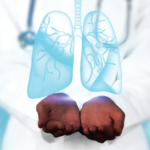 Gregory C. Gardner, MD, FACP, is the Gilliland-Henderson Professor of Medicine in the Division of Rheumatology at the University of Washington, and an adjunct professor of orthopedics and rehabilitation medicine at the University of Washington.
Gregory C. Gardner, MD, FACP, is the Gilliland-Henderson Professor of Medicine in the Division of Rheumatology at the University of Washington, and an adjunct professor of orthopedics and rehabilitation medicine at the University of Washington.
3 Physicians from the Author’s Combined Clinics Chime In
Lawrence Ho, MD, an ILD-trained pulmonologist in a combined ILD/rheumatology clinic:
“The combined rheumatology/ILD clinic is a huge benefit to both providers and patients. These visits allow for a true multidisciplinary approach as the rheumatologist and pulmonologist discuss the patient’s case either in front of the patient or immediately before or after the clinic visit. This communication is vital for our patients because they all present with complex disease, and often communication is lacking when patients are seen at different clinics or institutions. Not only are these clinics a great convenience for the patients because many travel from a distance and have busy work/life schedules, but the multidisciplinary approach instills trust and confidence in the medical team and the care provided.”
Judy Juo, MD, a third-year rheumatology fellow:
“I enjoy working in a combined clinic very much. In a combined clinic, we have the benefit of direct communication between subspecialists, which not only saves us time but also allows us to provide better patient care by coming up with a consistent treatment plan. It also saves the patients time because they do not have to go through the hassle of traffic, finding parking spaces, etc., more than once. Last but not least, I simply enjoy learning from and working with other subspecialists that I would have never met in person otherwise in a huge system like the University of Washington.”
Andrea Kalus, MD, a medicine-trained dermatologist and dermatology attending:
“Working in a combined setting provides a renewed joy of practice. Being able to observe elements of medical practice outside my own specialty rekindles the curiosity that drives so many of us to medicine to begin with. Good listening skills, responsive communication and, at times, challenging each other intellectually make sure things don’t fall through the cracks. Whenever possible I try to make time to attend the other specialties’ grand rounds or regional meetings because it helps deepen my understanding of the clinical content and also forges my relationship with a new community of providers. Referring providers appreciate the combined approach because it avoids treatment plans that have discrepancies. It is experienced almost universally positively by patients, even when they have to wait extra time. It works best as a referral service that provides guidance in diagnosis and treatment. For specialties like dermatology, it may come at the cost of productivity. Despite that, it is a highly desired service for referrals.”

